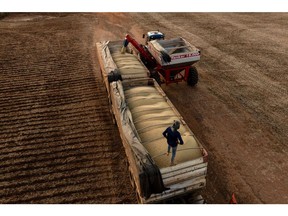Chinese tariffs on US agricultural goods will test the farm sectors of both nations.

Article content
(Bloomberg) — Chinese tariffs on US agricultural goods will test the farm sectors of both nations.
Article content
Article content
China’s swift retaliation in matching Washington’s blanket 34% levies will fall heavily on importers and exporters alike, choking off the flow of produce from the largely Republican states in the Midwest farm belt to over 1 billion consumers. As such, Beijing is betting that enough domestic resiliency has been built up since the trade war with the first Trump administration, and that American farmers have more to lose.
Advertisement 2
Article content
Soybeans are a case in point. China has made a largely successful bid in recent years to shift the country’s dependence to other, less antagonistic, suppliers such as Brazil. But the crop is still America’s top agricultural export to the country, worth over $12 billion in 2024. China has also cut its reliance on US corn and wheat, two other staples considered paramount to maintaining food security.
Other factors are playing to Beijing’s advantage. Domestic grain output is at record levels thanks to various campaigns to boost acreage and yields. Stockpiles are brimming and the surplus has been bolstered by the effect of a weaker economy on demand. The world production cycle means that US exports have now wound down until the fourth quarter in any case, further limiting the impact of tariffs.
Chinese agriculture stocks have soared in recent days, bucking the slump in equities elsewhere, as the government pushes hard on measures to lift self-sufficiency in farming.
Beijing has also made short-term preparations for a trade war, loading up on US soybeans in the months since Trump’s election victory. From November to February, it imported over 16 million tons, nearly 50% more than during the same period in the previous year.
Article content
Advertisement 3
Article content
The US used to be China’s top soybean supplier but the trade is now dominated by Brazil, which accounted for over 70% of imports in 2024. Still, the additional US cargoes that have landed recently will come in handy for stockpilers, who prefer the lower moisture levels of the American crop.
Five-Year Lows
There’s a cost in rising prices for Brazilian beans. The South American nation has also pushed out American corn after Beijing first approved shipments in 2022. US sales to China are now barely a trickle. It’s a similar story for wheat, with origins including Australia and Kazakhstan taking America’s share.
At the same time, local prices of the two grain crops are around five-year lows, creating pain for domestic farmers but establishing a useful cushion for a country that’s erecting import barriers.
The US is still China’s second-biggest source of foreign soybeans, the main protein for its vast herds of livestock. So a protracted trade war isn’t without risk, particularly once the next American harvest becomes available and other supplies become scarcer.
Prices of soybean meal for animal rations could rise in the short term, said Li Qiang, chief analyst with Shanghai JC Intelligence Co., a commodities consultancy. But the threat is viewed as manageable.
Advertisement 4
Article content
“China can either increase imports from South America or tap the state reserves,” he said. “The Chinese government and Chinese companies have made preparations for this.”
On the Wire
China slammed the US for threatening to raise tariffs and pledged to retaliate if Washington follows through, raising the stakes of the trade war between the world’s two largest economies.
Given the broadside to China’s economy from US tariffs, policymakers are expected to expedite stimulus — and news they’ve discussed measures to stabilize the economy and markets appears to confirm it’s in the works, said Bloomberg Economics.
China’s state-backed funds are planning to buy local stocks in a bid to support the market, as an escalating trade war with the US eroded this year’s rally.
China’s steel exports could drop 9-14% this year, the first fall since 2020, as anti-dumping measures increase globally, according to Bloomberg Intelligence.
Chinese shippers may see an outsized hit on earnings as the latest tariffs from US President Donald Trump risk hammering global trade.
President Xi Jinping’s decision to quickly retaliate against Donald Trump’s sweeping tariffs sent the world a clear message: If the US wants a trade war, China is ready to fight.
Advertisement 5
Article content
This Week’s Diary
(All times Beijing unless noted.)
Tuesday, April 8:
- Sungrow hosts Global Renewable Energy Summit in Hefei, Anhui, day 2
- EARNINGS: Jiangsu Shagang
Wednesday, April 9:
- China to release March aggregate finance & money supply data by April 15
- CSIA’s weekly polysilicon price assessment
- CCTD’s weekly online briefing on Chinese coal, 15:00
- Sungrow hosts Global Renewable Energy Summit in Hefei, Anhui, day 3
Thursday, April 10:
- China’s inflation data for March, 09:30
- China’s monthly CASDE crop supply-demand report
- CSIA’s weekly solar wafer price assessment
Friday, April 11:
- China’s weekly iron ore port stockpiles
- Shanghai exchange weekly commodities inventory, ~15:30
- EARNINGS: Zijin Mining
Article content







